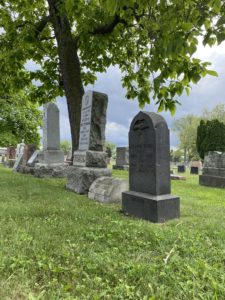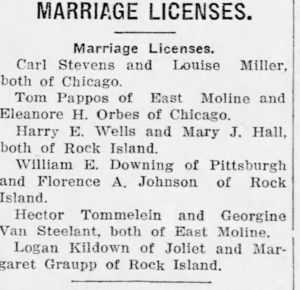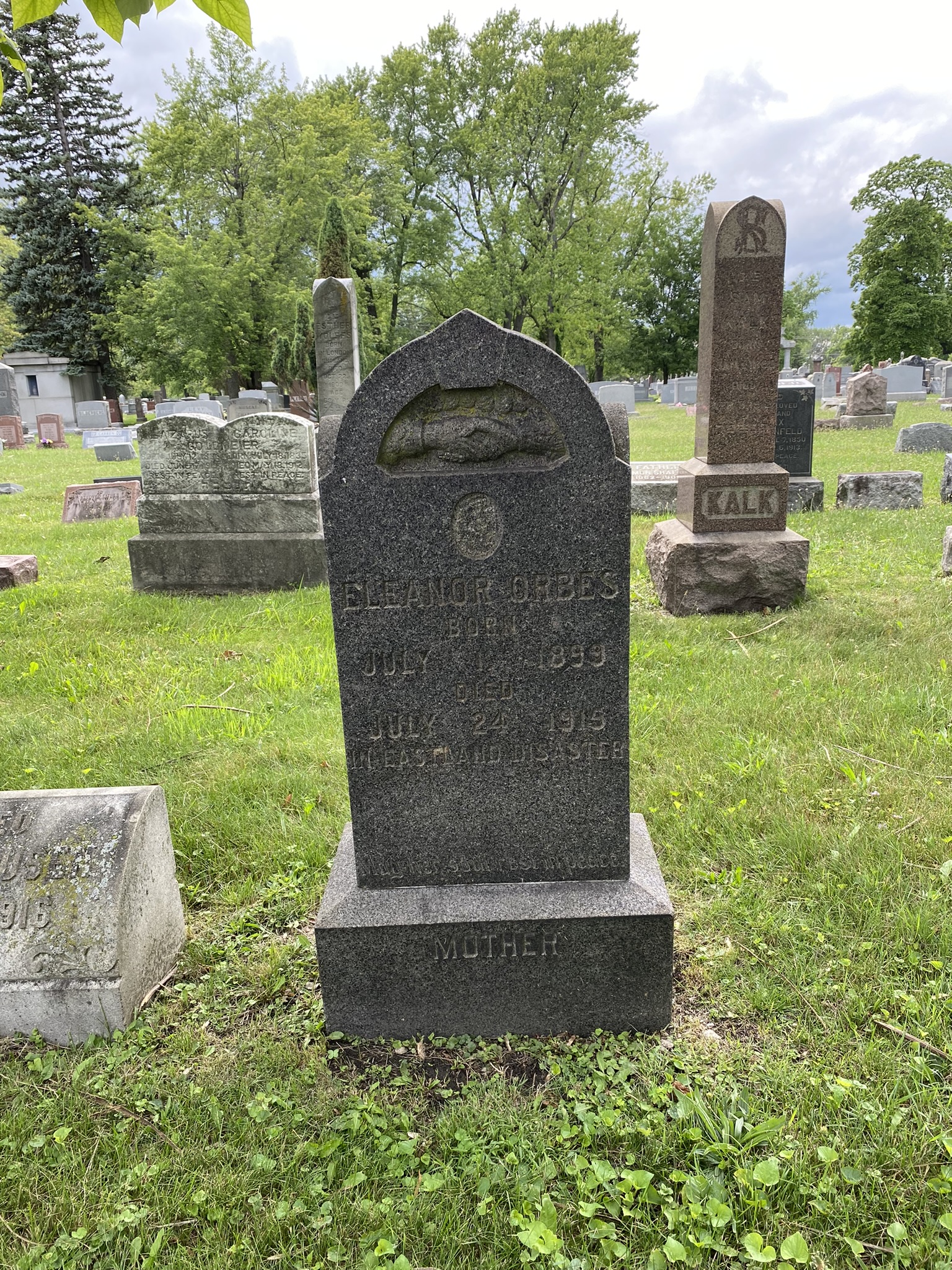1 July 1899 – 24 July 1915
The Eastland, one of five chartered excursion boats meant to ferry employees, their families and friends from Chicago over to the Michigan City shore for the annual Western Electric Company picnic, keeled over into the Chicago River while still at dock, trapping hundreds inside its hull and leading to the deaths of 844 of the 2,500 passengers aboard at the time of the incident which became known as The Eastland Disaster.
 Eleanor was born on 1 July 1899 in Chicago to Frank Orbes and Bertha Bendix. It’s unclear what happened to Frank or if her parents were ever actually married. Her mother was listed as the oldest daughter of her widowed mother on the 1900 census, living at home under her birth surname, and there was no infant listed as residing with the family.
Eleanor was born on 1 July 1899 in Chicago to Frank Orbes and Bertha Bendix. It’s unclear what happened to Frank or if her parents were ever actually married. Her mother was listed as the oldest daughter of her widowed mother on the 1900 census, living at home under her birth surname, and there was no infant listed as residing with the family.
Another curiosity of the 1900 Bendix family census information is that Bertha’s youngest-at-the-time sister Edith was also not listed as living with her apparently widowed mother and siblings. The youngest listed was six-year-old Alexander, leaving a gap where you would except 8-year-old Edith to be. This does make me wonder if perhaps both little girls were initially raised elsewhere such as with cousins or in an orphanage (a not-uncommon thing to do in those days). The 1940 census lists another unmarried Bendix sister named Dora who also does not show up living with her family prior to this on any census, so it’s a mystery where the little Bendix girls all were during their childhood years.
In 1907, Bertha married Mannheim Eckmann under her birth surname, so, again, it seems likely she and Frank were never married. Bertha and Mannheim had a son together in October 1908, and by 1910, this little family were living together with Eleanor listed as “Ella Eckmann (step-daughter), 10 years old.” One theory on her absence from the 1900 census is that Bertha had been pregnant with her at the time which would make Eleanor even younger than she listed on her headstone — but as that only ups the tragedy of her life, I prefer to believe she and her young aunt(s) were living elsewhere to lessen the burden on her mother and grandmother.
Yet another odd note is that the records seem to indicate that Henrietta was not actually widowed. Julius Bendix, Henrietta’s husband and the father of Bertha, Edith, presumably Dora, and at least six more children did not die until 1911, but the 1910 census still shows Henrietta “widowed” and living with one of her married sons along with youngest son Alex (no Dora to be found). It’s vaguely possible the “missing” daughters were living with their father after Julius and Henrietta parted ways, but I could find no 1900 or 1910 census information for him, so that must remain another mystery.

What we know about Eleanor herself is that in June 1914 at a very young age — regardless of birth year being 1899 or 1900 — she married Tom Pappos in Rock Island, Illinois. It is almost certain they married because they “had to,” and though I could find no record of a birth or a surviving child anywhere, Eleanor’s headstone has the word “MOTHER” inscribed across the bottom. A child was born and either did not survive or was put up for adoption or taken in by a relative as their own child. According to the Red Cross’s Eastland records, Eleanor continued to live with her mother and step-father, never sharing a home with her husband.
Her death record lists her as having worked at Western Electric, though the WE records do not list her in their Eastland report either under Orbes or Pappos or any variation on those names, and her obituary in the 31 July 1915 special edition of the Chicago Tribune (where her last name is misspelled “Orbst”) lists her occupation as cabaret singer. The Historical Society of Forest Park’s Eastland Disaster booklet states that she had been hired in that capacity to entertain the passengers, and while I can’t find a separate source to corroborate this, it would explain the confusion over her employment status. The Red Cross prepends a dismissive “aspiring” to “cabaret singer,” but our girl was on the boat working, so hush up, Red Cross.
In January of 1916, a basic probate claim was filed for Eleanor under the name Orbes and curiously enough, again in June of 1916, her husband Tom filed a probate claim under her married name (kind of, as he called her Eleanora Pappos, and he also sloppily entered her death year as 1916 or one month after his filing) where he claimed to be her sole survivor. (This is just more gross dirtbag behavior, Tom. Be better.) It’s unclear if Tom received any of the payout money, but it appears he did not unless something was settled after the fact. The records imply it was Eleanor’s mother Bertha who received $249.90 in life insurance and $200 from the Eastland Fund, and I hope he never saw a dime. The fact that the Red Cross payout was only $200 is also evidence that there was no surviving child as the amount earmarked for surviving children of any lost parents was fairly complex and allowed for ongoing support of the minor children.
From the few crumbs I was able to find in the records, it appears Tom never remarried nor did he ever list himself as widowed despite his filing of the probate claim. The census records indicate he had immigrated from Greece in 1911 and was about seven years Eleanor’s senior. He worked mostly in the restaurant industry and died in 1976.
Prior to 1920 — and most likely prior to 1915 as Edith was the person listed as having identified Eleanor’s body — Henrietta and Edith had moved in with Bertha’s family. Edith died in 1940 at just 47 years old; Henrietta died in 1946; and Bertha died just four years later in 1950.
Another tragedy seems to have struck Bertha as her only son with Mannheim, Eleanor’s little half-brother Harry, was committed to Dixon State Hospital prior to 1930 and lived out most of his life there from what I can tell from available public records. Dixon was originally established as a home for people with epilepsy but expanded to include those with developmental issues as well, so it’s unclear why he was there. He died in 1981 on his 72nd birthday in Chicago, never having married. Dixon — which was yet another state institution with a brutal history — was featured in an expose in the late 50s and hopefully was improved after that, but I believe it was still in operation as the Dixon Developmental Center at the time of Harry’s death. His Social Security death record indicates his last address (I presume for benefits payments) was still the town of Dixon, at least, so my theory is he was transferred to a Chicago hospital due to whatever end-of-life health issues he faced.
While Harry’s parents and grandmother are buried at Irving Park, he is buried at Waldheim near his half-sister and grandfather.
Eleanor’s headstone is fairly elaborate in its detail. It has complete dates and two separate inscriptions, one noting that her death was in the Eastland Disaster; the other indicating she was someone’s mother. There was also once a cameo which I’m heartbroken is long gone. She is buried in the singles section of the Free Sons of Israel cemetery (the east section, which is across Des Plaines Avenue from where Samuel Widran is buried by the river), and I do wonder if that congregation made some accomodations for the victims’ families to assist in the aftermath of the tragedy. It’s a lovely spot under the trees.
RIP Eleanor and family
Please visit my Instagram for any questions or comments on this post!
Thank you to the Historical Society of Forest Park (HSFP) and to the Eastland Disaster Historical Society for providing additional documentation in support of this project. A very special thank you to Diane Grah, who created the HSFP’s Eastland Disaster Booklet, for providing additional context for my research on Eleanor’s life.
